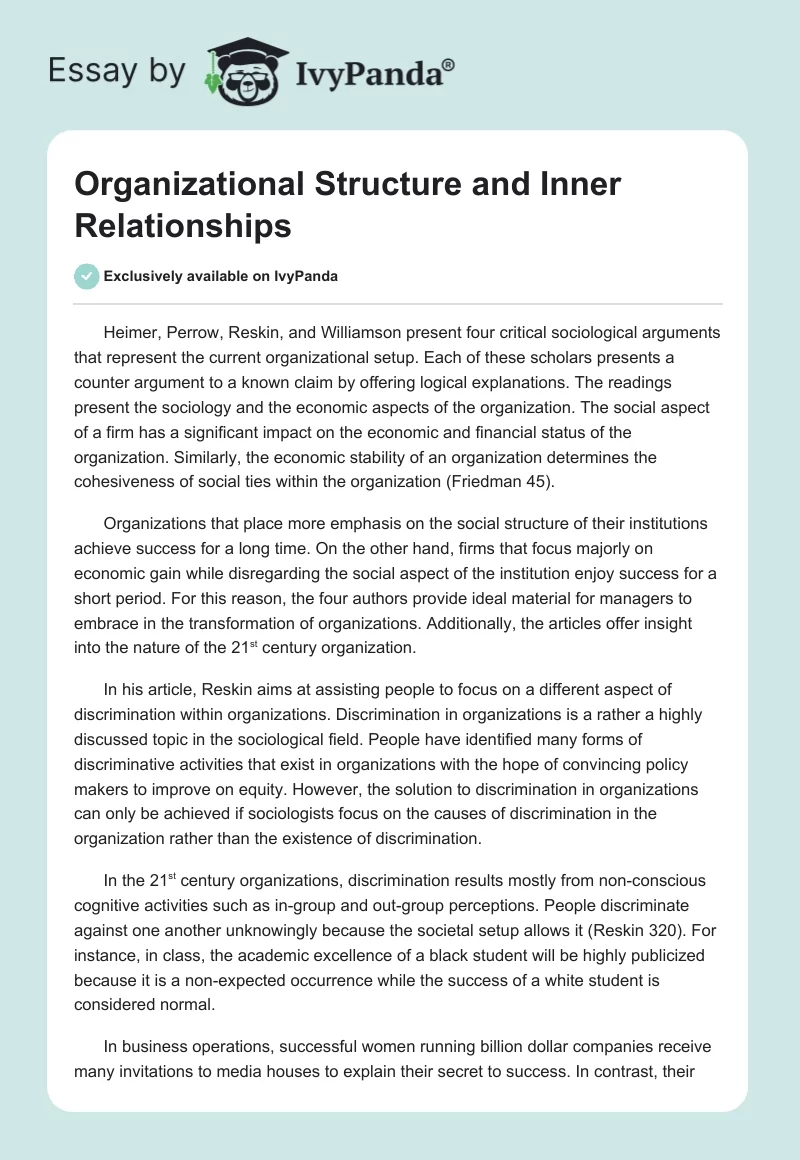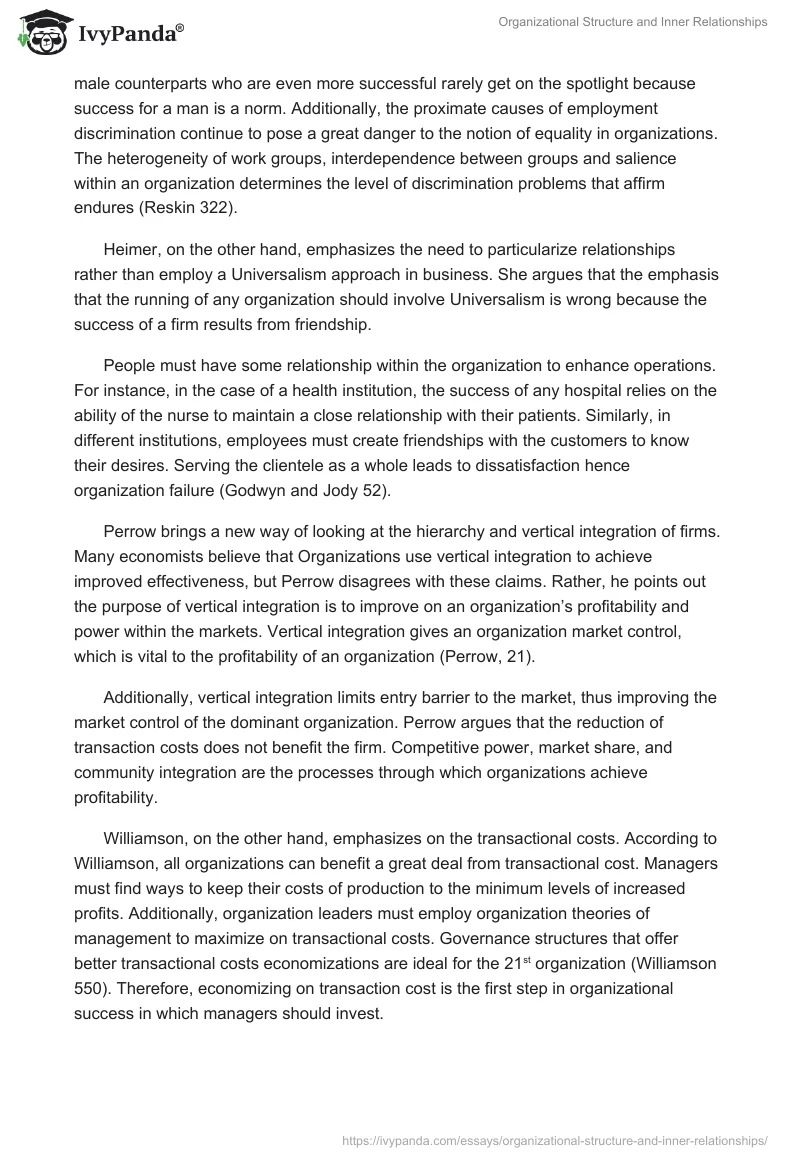Heimer, Perrow, Reskin, and Williamson present four critical sociological arguments that represent the current organizational setup. Each of these scholars presents a counter argument to a known claim by offering logical explanations. The readings present the sociology and the economic aspects of the organization. The social aspect of a firm has a significant impact on the economic and financial status of the organization. Similarly, the economic stability of an organization determines the cohesiveness of social ties within the organization (Friedman 45).
Organizations that place more emphasis on the social structure of their institutions achieve success for a long time. On the other hand, firms that focus majorly on economic gain while disregarding the social aspect of the institution enjoy success for a short period. For this reason, the four authors provide ideal material for managers to embrace in the transformation of organizations. Additionally, the articles offer insight into the nature of the 21st century organization.
In his article, Reskin aims at assisting people to focus on a different aspect of discrimination within organizations. Discrimination in organizations is a rather a highly discussed topic in the sociological field. People have identified many forms of discriminative activities that exist in organizations with the hope of convincing policy makers to improve on equity. However, the solution to discrimination in organizations can only be achieved if sociologists focus on the causes of discrimination in the organization rather than the existence of discrimination.
In the 21st century organizations, discrimination results mostly from non-conscious cognitive activities such as in-group and out-group perceptions. People discriminate against one another unknowingly because the societal setup allows it (Reskin 320). For instance, in class, the academic excellence of a black student will be highly publicized because it is a non-expected occurrence while the success of a white student is considered normal.
In business operations, successful women running billion dollar companies receive many invitations to media houses to explain their secret to success. In contrast, their male counterparts who are even more successful rarely get on the spotlight because success for a man is a norm. Additionally, the proximate causes of employment discrimination continue to pose a great danger to the notion of equality in organizations. The heterogeneity of work groups, interdependence between groups and salience within an organization determines the level of discrimination problems that affirm endures (Reskin 322).
Heimer, on the other hand, emphasizes the need to particularize relationships rather than employ a Universalism approach in business. She argues that the emphasis that the running of any organization should involve Universalism is wrong because the success of a firm results from friendship.
People must have some relationship within the organization to enhance operations. For instance, in the case of a health institution, the success of any hospital relies on the ability of the nurse to maintain a close relationship with their patients. Similarly, in different institutions, employees must create friendships with the customers to know their desires. Serving the clientele as a whole leads to dissatisfaction hence organization failure (Godwyn and Jody 52).
Perrow brings a new way of looking at the hierarchy and vertical integration of firms. Many economists believe that Organizations use vertical integration to achieve improved effectiveness, but Perrow disagrees with these claims. Rather, he points out the purpose of vertical integration is to improve on an organization’s profitability and power within the markets. Vertical integration gives an organization market control, which is vital to the profitability of an organization (Perrow, 21).
Additionally, vertical integration limits entry barrier to the market, thus improving the market control of the dominant organization. Perrow argues that the reduction of transaction costs does not benefit the firm. Competitive power, market share, and community integration are the processes through which organizations achieve profitability.
Williamson, on the other hand, emphasizes on the transactional costs. According to Williamson, all organizations can benefit a great deal from transactional cost. Managers must find ways to keep their costs of production to the minimum levels of increased profits. Additionally, organization leaders must employ organization theories of management to maximize on transactional costs. Governance structures that offer better transactional costs economizations are ideal for the 21st organization (Williamson 550). Therefore, economizing on transaction cost is the first step in organizational success in which managers should invest.
The Similarities and Differences between Different Arguments
Reskin and Heimer’s arguments have certain similarities and differences. Both scholars emphasize the importance of addressing people as individuals rather than as a group. Discriminations in organizations arise because people view each other as members of either an in-group or an out-group. Members of a different group judge the action of a person depending on the group in which they belong, thus increasing chances of discrimination.
In Heimer’s arguments, treating people as individuals enhance success within an organization. Additionally, handling people as individuals give managers a better chance to develop different skills from different employees (Godwyn and Jody 55). Universalism limits the one-on-one interaction between leaders and their subordinates, which is detrimental to the organization. For example, organizations are made up of people with different intellectual levels. Universalizing the training process will result in biased results because not all people can learn from the same phase.
Both papers advocate interdependence between people in organizations. Coordination of efforts and the culture of helping one another bring good fortune to the organization. On the other hand, the approaches used by the two scholars differ in that; Reskin argues for heterogeneity while Heimer advocates homogeneity. Heimer arguments suggest that leaders should group people to enhance the effectiveness of the firm. Reskin, on the other hand, argues that managers must maintain heterogeneity in groups to reduce the in-group and out-group perceptions (Reskin 325).
The arguments of Perrow and Williamson also present certain comparisons. The authors attribute the economic stability of an organization to different aspects of the organization management. Perrow argues that organizations can only achieve profitability by focusing on vertical integration and competitiveness. Perrow argues that lowering transactional costs does not benefit the firm financially, thus making the approach unnecessary in profit maximization (Perrow 17).
Williamson, on the other hand, stresses the importance of economizing transaction costs for the greater good of the organization. Williamson emphasizes the importance of efficiency and effectiveness in business transactions to improve the organization’s profitability. In his view, efficiency and ideal governance help in economizing transactional costs, thus raising the profitability levels of the company (Williamson 570). Perrow, on the other hand, argues that the market control than an organization possesses determines its profitability. Although both authors use different approaches, they agree on the fact that organizations must use unique governance structures to enhance the economic success of their institutions.
The four authors present two distinct areas of an organization management. The social and the economic sections of a firm interact with one another and each has a significant influence on the other. As such, the four arguments comprehend one another in many ways. Social cohesion within an organization makes it easy for managers to structure the best model for profit maximization.
For instance, the vertical integration that Perrow advocates depends on employees’ willingness to view each other as competent individuals. Additionally, the approach supports Heimer’s idea of viewing people as individuals rather than members of a certain group. Vertical integration requires varied skills and levels of knowledge within the firm (Perrow 19). It is impossible to achieve an ideal hierarchy in an organization if the leaders do not value the unique characteristics of individuals.
On the other hand, managing transactional costs, as argued by Williamson, will require employee support. Employees will only support a move suggested by another group if the organization values heterogeneity in business transactions. In-group and out-group competitions are detrimental to an organization, and they slow down the process of transaction cost Economization.
In general, the social aspect of the organization has a significant impact on the economic and financial status of the firm. Research indicates that the most successful organizations around the world invest more on human resource and customer satisfaction. Employee productivity improves if managers satisfy the social needs of the staff. Customers, on the other hand, enjoy visiting organizations that not only serves their physical needs, but also offers a serene environment for social satisfaction.
Satisfied employees develop good relationships with the clients, thus improving the effectiveness and profitability of the organization (Friedman 91). Economic success, on the other hand, motivates employees to improve their performance within the organization.
Works Cited
Friedman, Joel W. Employment discrimination. New York: Wolters Kluwer Law & Business, 2014. Print.
Godwyn, Mary, and Jody H. Gittell. The Sociology of Organizations: structures and relationships. Thousand Oaks: Pine Forge Press, 2012. Print.
Perrow, Charles. Markets, hierarchies and hegemony, Boston: Harvard University Press, 1988. Print.
Reskin, Barbara. “The proximate causes of employment discrimination.” Contemporary Sociology, 29. 2 (2000): 319-328. Print.
Williamson, Oliver. “The economics of organization: the transaction cost approach.” American journal of sociology, 87.3 (1981): 548-577. Print.


